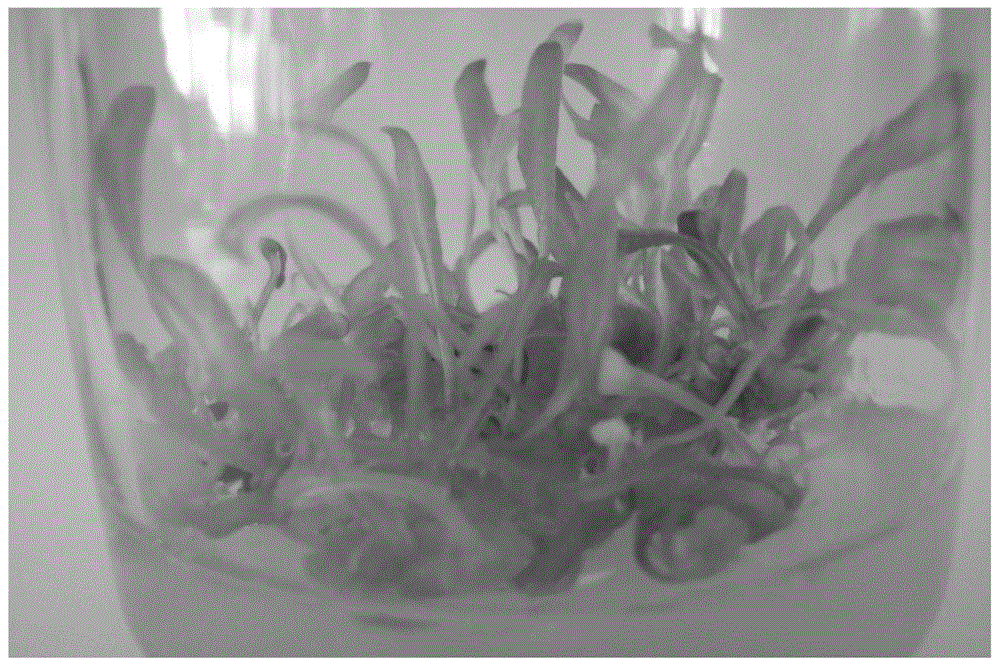A kind of method utilizing rubber grass blade to regenerate plant
A technology for regenerating plants and rubber grass, applied in the field of plant cell engineering, can solve problems such as unsatisfactory induction effect, and achieve the effects of short cycle, high reproduction coefficient and high transplant survival rate
- Summary
- Abstract
- Description
- Claims
- Application Information
AI Technical Summary
Problems solved by technology
Method used
Image
Examples
Embodiment 1
[0034] Present embodiment relates to a kind of method utilizing rubber grass blade regeneration plant, and its concrete steps are as follows:
[0035] 1) Take young rubber grass leaves, clean the surface with tap water, transfer the cleaned leaves to the ultra-clean workbench and place them in a sterile culture bottle, add 70% alcohol to disinfect the surface for 1 min, and then use Wash 2-3 times with sterile water, then change to a sterile culture bottle, add 15% hydrogen peroxide to sterilize for 7 minutes, then rinse with sterile water 5-6 times, after cleaning, put the leaves on a plate with filter paper Drain the water on the surface and set aside;
[0036] 2) Cut the leaves into about 1-2cm 2 Explants of the same size were inoculated into callus induction medium (see figure 1 ), the culture temperature is 23±2°C, the light intensity is 2000-2500 Lux, and the light is 12 hours a day. The callus induction medium is: MS+2.0mg / L 6-BA+0.5mg / L IAA, and add 30g / L sucrose, 7...
Embodiment 2
[0043] Present embodiment relates to a kind of method utilizing rubber grass blade regeneration plant, and its specific steps are as follows:
[0044] 1) Take young rubber grass leaves, clean the surface with tap water, transfer the cleaned leaves to the ultra-clean workbench and place them in a sterile culture bottle, add 70% alcohol to disinfect the surface for 1 min, and then use Wash 2-3 times with sterile water, then change to a sterile culture bottle, add 15% hydrogen peroxide to sterilize for 7 minutes, then rinse with sterile water 5-6 times, after cleaning, put the leaves on a plate with filter paper Drain the water on the surface and set aside.
[0045] 2) Cut the leaves into about 1~2cm 2 The explants of different sizes are inoculated into the callus induction medium, the culture temperature is 23±2° C., the light intensity is 2000-2500 Lux, and the light is 12 hours a day. The callus induction medium is: MS+1.8mg / L 6-BA+0.4mg / L NAA, with 25g / L sucrose, 6g / L agar,...
Embodiment 3
[0052] Present embodiment relates to a kind of method utilizing rubber grass blade regeneration plant, and its specific steps are as follows:
[0053] 1) Take young rubber grass leaves, clean the surface with tap water, transfer the cleaned leaves to the ultra-clean workbench and place them in a sterile culture bottle, add 70% alcohol to disinfect the surface for 1 min, and then use Wash 2-3 times with sterile water, then change to a sterile culture bottle, add 15% hydrogen peroxide to sterilize for 7 minutes, then rinse with sterile water 5-6 times, after cleaning, put the leaves on a plate with filter paper Drain the water on the surface and set aside;
[0054] 2) Cut the leaves into about 1-2cm 2 The explants of different sizes are inoculated into the callus induction medium, the culture temperature is 23±2° C., the light intensity is 2000-2500 Lux, and the light is 12 hours a day. The callus induction medium is: MS+2.2mg / L6-BA+0.6mg / L IAA, add 35g / L sucrose, 8g / L agar, a...
PUM
 Login to View More
Login to View More Abstract
Description
Claims
Application Information
 Login to View More
Login to View More - R&D
- Intellectual Property
- Life Sciences
- Materials
- Tech Scout
- Unparalleled Data Quality
- Higher Quality Content
- 60% Fewer Hallucinations
Browse by: Latest US Patents, China's latest patents, Technical Efficacy Thesaurus, Application Domain, Technology Topic, Popular Technical Reports.
© 2025 PatSnap. All rights reserved.Legal|Privacy policy|Modern Slavery Act Transparency Statement|Sitemap|About US| Contact US: help@patsnap.com



